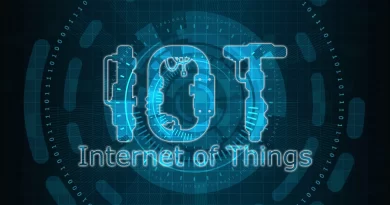The Potential of the Internet of Things (IoT) in Improving Supply Chain Management
The Internet of Things (IoT) has the potential to revolutionize supply chain management by providing real-time tracking and monitoring of goods, optimizing routes and logistics, and improving inventory management.
The Internet of Things (IoT) refers to the network of physical devices, vehicles, buildings, and other objects that are embedded with sensors, software, and network connectivity, allowing them to collect and exchange data.
Supply chain management refers to the process of planning, coordinating, and controlling the movements and storage of goods, services, and related information from the point of origin to the point of consumption. It involves managing the flow of resources, including raw materials, finished products, and information, from suppliers to manufacturers to wholesalers to retailers to end customers. The goal of supply chain management is to ensure that the right products are delivered to the right place at the right time in a cost-effective and efficient manner.
Current state of supply chain management
The current state of supply chain management is characterized by a number of challenges and inefficiencies. These include:
Complexity: Supply chains have become increasingly complex, with multiple tiers of suppliers, manufacturers, distributors, and retailers involved in the process. This can make it difficult to maintain visibility and control over the flow of goods and information.
Inefficiency: Traditional supply chain management practices can be time-consuming and labor-intensive, leading to inefficiencies and higher costs.
Lack of visibility: It can be difficult to obtain real-time information about the status of orders, inventory levels, and other key supply chain metrics. This can lead to delays and other issues.
Limited flexibility: Traditional supply chain systems can be inflexible, making it difficult to quickly respond to changes in demand or other disruptions.
Risk of errors: Manual processes and the use of multiple systems can increase the risk of errors, such as incorrect orders or missed deliveries.
Environmental impact: The transportation and storage of goods can have a significant impact on the environment, and traditional supply chain practices may not be sustainable in the long term.
Potential of the IoT in improving supply chain management
The Internet of Things (IoT) has the potential to significantly improve supply chain management by addressing many of the challenges and inefficiencies that exist in traditional systems. Some of the key ways in which the IoT can improve supply chain management include:
Improved tracking and visibility: By attaching IoT sensors to products, it is possible to track the movement of goods in real-time and obtain a detailed view of their location and status at any given time. This can help to improve visibility and reduce the risk of errors or delays.
Enhanced forecasting and planning: The data collected by IoT sensors can be used to improve forecasting and planning, allowing companies to better anticipate demand and optimize their supply chain operations.
Increased automation and efficiency: The IoT can facilitate automation and the use of robotics in supply chain processes, leading to increased efficiency and reduced labor costs.
Reduced errors and waste: By automating processes and improving visibility, the IoT can help to reduce errors and waste in the supply chain.
Improved decision-making and agility: The real-time data provided by the IoT can enable companies to make more informed decisions and respond more quickly to changes in demand or other disruptions. This can increase the agility of the supply chain and allow companies to better compete in a dynamic business environment.
Examples of the IoT in action in supply chain management
There are many examples of the Internet of Things (IoT) being used to improve supply chain management. Some examples include:
Tracking and monitoring shipments: By attaching IoT sensors to shipments, companies can track their location and status in real-time and receive alerts if there are any delays or issues.
Improving warehouse efficiency: IoT sensors and automation technologies can be used to optimize warehouse operations, such as by automating the picking and packing of orders or by improving the accuracy of inventory management.
Predictive maintenance: By attaching sensors to equipment and vehicles, companies can monitor their performance and predict when maintenance is required. This can help to reduce downtime and improve the efficiency of the supply chain.
Temperature monitoring: In industries such as healthcare and food and beverage, it is important to maintain certain temperature ranges during transportation to ensure the integrity of the products. IoT sensors can be used to monitor and record the temperature of shipments in real-time to ensure that they are being handled properly.
Supply chain financing: The use of blockchain and smart contracts in the supply chain can enable companies to access financing based on the real-time status of their orders and inventory. This can help to improve cash flow and reduce the risk of delays or other issues.
Challenges and considerations for implementing the IoT in supply chain management
While the Internet of Things (IoT) has the potential to significantly improve supply chain management, there are also a number of challenges and considerations that need to be taken into account when implementing IoT solutions. Some of the key challenges and considerations include:
Cost and resource considerations: Implementing the IoT in the supply chain can require a significant investment in technology, infrastructure, and resources. Companies need to carefully evaluate the potential costs and benefits of IoT projects to ensure that they are justified.
Security and data privacy concerns: The use of IoT devices and the collection and sharing of large amounts of data raise important security and data privacy concerns. Companies need to implement appropriate security measures to protect against cyber threats and ensure that they are complying with relevant laws and regulations.
Integration with existing systems and processes: The IoT can generate a large amount of data, and it is important to ensure that this data is integrated with existing systems and processes in a way that is useful and actionable. This can require significant effort and resources to implement.
Change management: Implementing the IoT in the supply chain will likely require significant changes to existing systems and processes, and it is important to manage these changes effectively to ensure a smooth transition. This can include providing training and support to employees, and communicating with stakeholders about the changes.




